Unraveling the Ritual of British Tea
How and where to enjoy the very British tradition of tea time in London
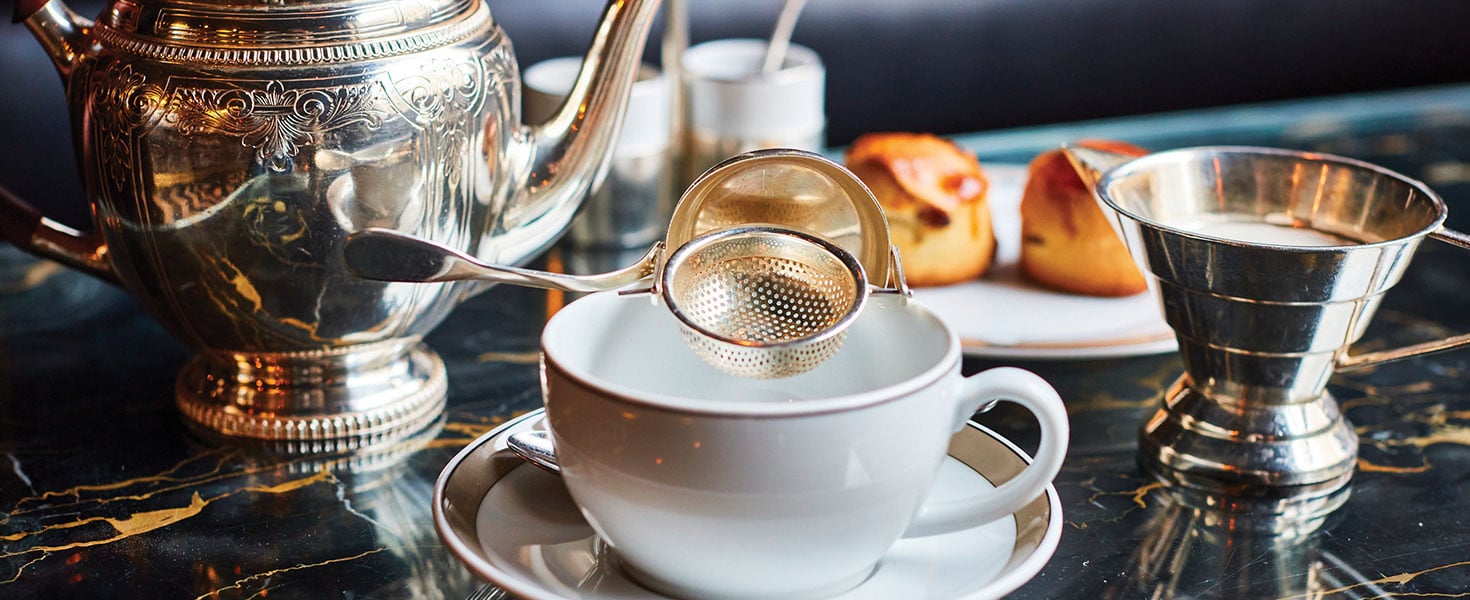
The Wolseley, a grand café in London’s Mayfair section, checks all the right boxes for the nearly 200-year-old British tradition of afternoon tea. A handsome space with vaulted ceilings and marble floors. Servers in bespoke uniforms gliding around the room. Tea served in individual silver pots. And the centerpiece of this classic experience: a three-tiered silver caddy loaded with savories and sweets.
On the caddy’s top tier are warm scones, studded with raisins, accompanied by clotted cream and jam. On the bottom dish are sandwiches in such flavors as smoked salmon, cucumber and cream cheese, and roast beef and horseradish—crusts neatly trimmed. But it’s the middle tier that gilds the sugar lily: an assemblage of miniature pastries, including vanilla cheesecake, a strawberry-blackberry tart and the Wolseley Battenberg, a checkerboard cake enrobed in marzipan.
When in London, afternoon tea is a must-do, whether it’s your first time there or, in my case, a return visit that also marked my first international travel since before the pandemic. Whatever the circumstances, this very British ritual offers a perfect way to take a break from all the museum-going, shopping and strolling, or to enjoy a strategically timed bite before the theater or other evening activities.
 The Wolseley offers daily afternoon tea service as well as separate menus for breakfast, lunch/dinner, and all day/late night. Photo courtesy of The Wolseley
The Wolseley offers daily afternoon tea service as well as separate menus for breakfast, lunch/dinner, and all day/late night. Photo courtesy of The Wolseley
DON’T CALL IT ‘HIGH TEA’
Afternoon tea and high tea are often used interchangeably, but they are not one and the same. We can thank Anna Russell, the seventh Duchess of Bedford, a lady-in-waiting to Queen Victoria, for inventing the idea of afternoon tea in 1840. She wanted to bridge the gap between luncheon and dinner and to ward off that “sinking feeling” around 5 o’clock, so she concocted a mini-meal of bread and butter and cake––washed down with tea.
Afternoon tea soon became the fashion for the aristocracy, and, over the centuries, it evolved into the more substantive combination of savories and sweets that’s now generally served between 3 p.m. and 5 p.m. By contrast, high tea is a light supper paired with tea that’s served after 5 p.m. It might include roasted meat, fish or an egg dish, along with the requisite breads and sweets.
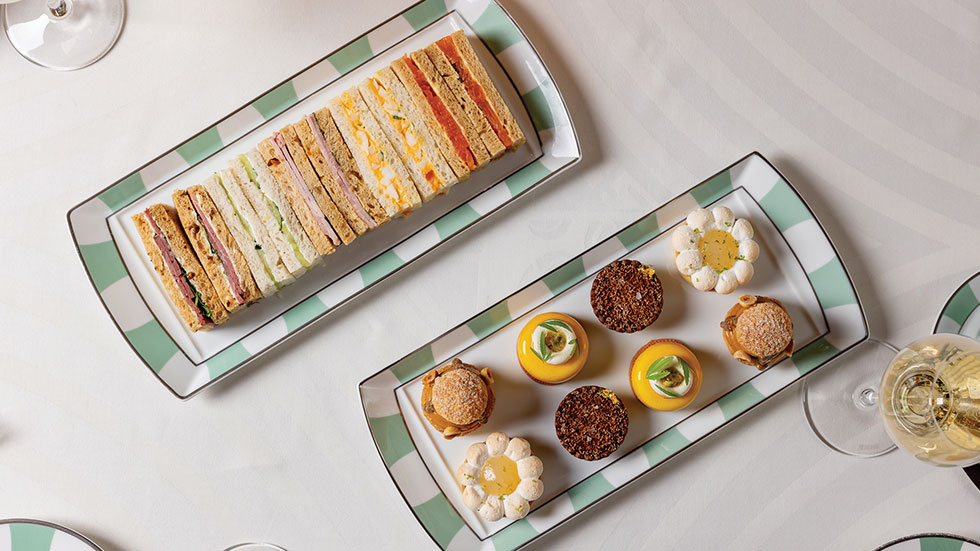 Sandwiches and sweets make a statement on Claridge’s signature striped jade-and-white French porcelain dishes. Photo courtesy of Claridge’s Hotel
Sandwiches and sweets make a statement on Claridge’s signature striped jade-and-white French porcelain dishes. Photo courtesy of Claridge’s Hotel
A ROYAL PEDIGREE
To pass through the double doors of Fortnum & Mason’s imposing brick and limestone storefront on Piccadilly Street is to walk into a palace of food and drink. In the sprawling ground-floor retail space, an entire wall is dedicated to preserves, while cases stocked with coffee, biscuits—and, of course, teas—compete for your attention. (Other floors offer a journey through prepared foods, holiday items and housewares and even include an ice cream parlor.) Dating to 1707, Fortnum’s from its origins has enjoyed a royal connection. One of the founders, William Fortnum, was a footman in Queen Anne’s household. During the Crimean War in 1856, Fortnum’s supplied an order of concentrated beef tea to none other than Florence Nightingale to help nurse the wounded in a hospital in Turkey.
In the early 20th century, King Edward VII charged Fortnum’s with bringing to London the “finest tea in all of the land,” a combination of Assam from India and Flowery Pekoe from Sri Lanka that still makes up the brand’s signature Royal Blend. In 2012, Queen Elizabeth II herself was on hand to help open the Diamond Jubilee Tea Salon, marking her 60 years on the throne. This fourth-floor space transports you to a more gracious era, with its hand-painted walls, fresh flowers and live piano music. The current Platinum Jubilee menu commemorates Elizabeth II’s 70 years on the throne and includes sandwiches of Coronation Chicken (a curried chicken salad first prepared for the Queen’s 1953 coronation), along with Cotswolds Legbar egg mayonnaise, Suffolk cured ham with English mustard, cucumber with mint cream cheese and smoked trout with dill.
Even the pastries carry symbolic significance, highlighting points of local pride like the Queen’s former ownership of all the swans in the UK (a puff pastry swan, filled with violet crème and topped with a rose petal) and the crown jewels (a marquise-shaped chocolate mousse candy topped with a candy pearl).
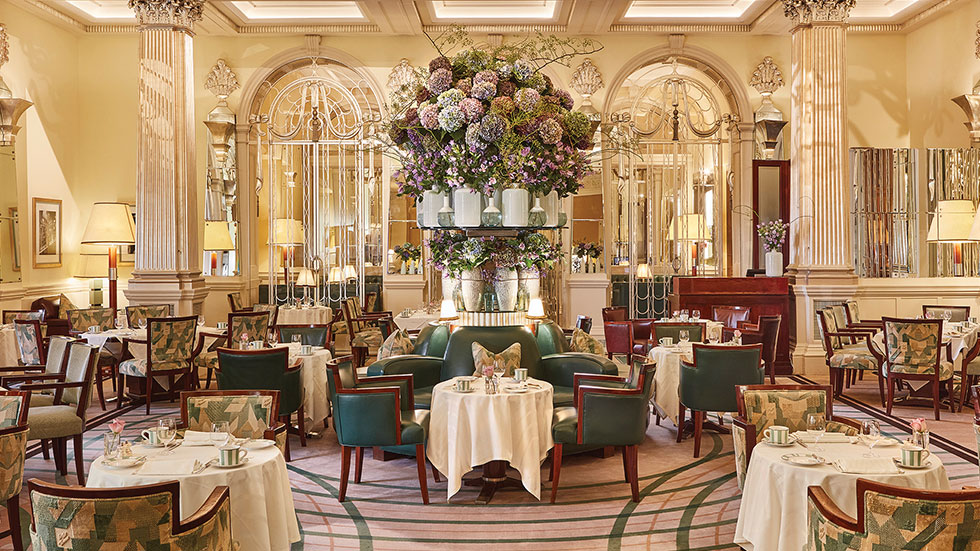 Fortnum and Mason’s and the Reading Room at Claridge’s. Photo courtesy of Fortnum and Mason
Fortnum and Mason’s and the Reading Room at Claridge’s. Photo courtesy of Fortnum and Mason
LUXE HOTEL EDITIONS
For anyone who’s binge-watched The Crown or fantasized about life among the British elite, afternoon tea at a posh hotel is a must. The Foyer & Reading Room at Claridge’s Hotel in Mayfair defines understated elegance with its original Art Deco mirrors, muted pastel shades and luminous Chihuly glass sculpture. The tea experience is not without its touches of whimsy—in the form of the hotel’s signature striped jade-and-white French porcelain teacups and saucers. It becomes even more festive with the addition of champagne.
But for the actual tea, nothing is left to chance. The tea, including Claridge’s own blend, is sourced by Rare Tea Company founder Henrietta Lovell. Servers have received special training for prepping the perfect cup, taking into account the weight of the tea leaves, the temperature of the water and a guest’s preference for strength.
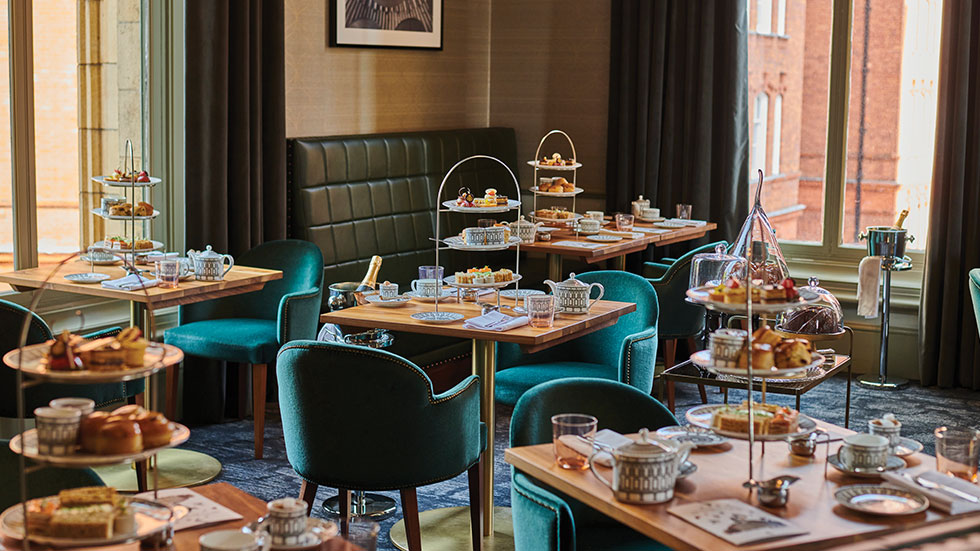 The Royal Albert Hall has been serving afternoon tea for more than a century. Photo courtesy of Royal Albert Hall
The Royal Albert Hall has been serving afternoon tea for more than a century. Photo courtesy of Royal Albert Hall
Perhaps you’ve read enough British mystery novels to understand the central role of the private club to the plot. At the circa-1892 St. James’s Hotel and Club in Mayfair, you can channel your inner Sherlock Holmes while enjoying afternoon tea inspired by recipes developed by a chef who later became chief cook for Queen Victoria. In cozy rooms outfitted with sofas and easy chairs, you can sample a proprietary loose tea blend from The East India Company, nibble on savories like smoked Scottish salmon on brown bread or ham and chutney on white bread, and finish with a classic Victoria sponge cake (layered with cream and either jam or fruit).
Whether you choose a pedigreed food hall, classic hotel or posh club, the afternoon tea ritual remains—reassuringly—the same.
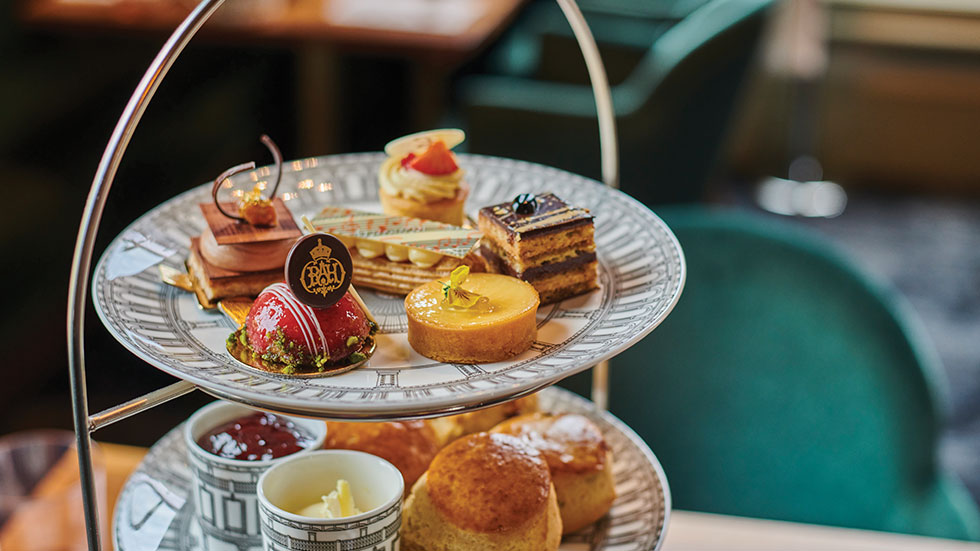 Pastries celebrate the Royal Albert Hall’s rich musical heritage. Photo courtesy of Royal Albert Hall
Pastries celebrate the Royal Albert Hall’s rich musical heritage. Photo courtesy of Royal Albert Hall
THEMED TEAS
There’s an afternoon tea for seemingly every interest.
At Royal Albert Hall, a storied concert venue that has hosted the likes of Winston Churchill, Albert Einstein, Muhammad Ali, The Beatles and Adele, afternoon tea features a crown-shaped pastry in honor of its namesake, Queen Victoria’s beloved husband. Views overlook the Albert Memorial in Hyde Park.
The landmark Church of the St. Martin in the Fields on Trafalgar Square serves afternoon tea in the Café in the Crypt, where you can down your cuppa, sandwiches and scones under original vaulted brick ceilings and peruse the historic tombstones that line the floor.
The Bard himself inspires tea at the Swan at Shakespeare’s Globe theater on the Thames with a Romeo and Juliet tea that includes pastries such as “A Rose by Any Other Name” (a raspberry and lychee cream éclair infused with rose).
Science—not the culinary arts—provides the theme for the Ampersand Hotel’s version that features a rocket-shaped tea caddy, jams in petri dishes, and sweets in the form of chocolate spacemen, dinosaur biscuits and flying saucer-shaped macarons. Meanwhile, the tea add-on at the Warner Bros. Studio Tour London, home to The Making of Harry Potter experience, conjures sweets like Golden Snitch Choux Buns and Luna Lovegood Little Loaf.
